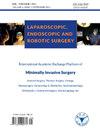A new approach to laparoscopic skill assessment: Motion smoothness and bimanual coordination
Q3 Medicine
引用次数: 0
Abstract
Objective
Reliable and objective methods for assessing surgical skill are essential for improving surgical skills and clinical outcomes. While conventional methods rely on subjective evaluations, motion analysis can offer a quantitative alternative. This study aims to use motion tracking data to analyze the motion smoothness and bimanual coordination of various surgical skill levels during laparoscopic surgery.
Methods
The participants were recruited and grouped into an expert group, an intermediate group, and a novice group on the basis of their experience with laparoscopic surgery. They completed peg transfer, bimanual peg transfer, and rubber band translocation tasks. Motion smoothness was assessed via logarithmic dimensionless tooltip motion jerk, and the dynamic time warping metric of tooltips velocities was employed to assess bimanual coordination.
Results
Seventeen participants, with four experts, five intermediates, and eight novices, were included. Compared with novices, the experts exhibited smoother motion in both the dominant hand (peg transfer: 16.30 vs. 18.05, p = 0.004; bimanual peg transfer: 15.21 vs. 17.45, p = 0.004; rubber band translocation: 14.32 vs. 15.87, p = 0.004) and non-dominant hand (peg transfer: 16.32 vs. 18.22, p = 0.004; bimanual peg transfer: 15.32 vs. 17.52, p = 0.004; rubber band translocation: 14.33 vs. 15.77, p = 0.004), and superior bimanual coordination (peg transfer: 8.77 m/s vs. 13.28 m/s, p = 0.004; bimanual peg transfer: 6.29 m/s vs. 11.13 m/s, p = 0.004; rubber band translocation: 4.50 m/s vs. 7.13 m/s, p = 0.004) across all tasks. They also outperformed intermediates in motion smoothness in the non-dominant hand and bimanual coordination in the peg transfer (16.32 vs. 17.35, p = 0.016; 8.77 m/s vs. 11.89 m/s, p = 0.016) and bimanual peg transfer (15.32 vs. 16.22, p = 0.016; 6.29 m/s vs. 8.63 m/s, p = 0.032) tasks. Similarly, intermediates demonstrated smoother motion in the non-dominant hand (peg transfer: 17.35 vs. 18.22, p = 0.002; bimanual peg transfer: 16.22 vs. 17.52, p = 0.002) and dominant hand (bimanual peg transfer: 16.06 vs. 17.45, p = 0.011), and better bimanual coordination (peg transfer: 11.89 m/s vs. 13.28 m/s, p = 0.002; bimanual peg transfer: 8.63 m/s vs. 11.13 m/s, p = 0.002) than novices did in these tasks.
Conclusion
This study revealed that motion smoothness and bimanual coordination are capable of facilitating surgical skill differentiation across various skill levels. These findings underscore the utility of motion metrics for objective surgical skill assessment, potentially reducing the subjectivity, bias, and associated costs of conventional assessment approaches.
一种新的腹腔镜技能评估方法:运动平滑性和双手协调性
目的可靠、客观的评估手术技能的方法对于提高手术技能和临床效果至关重要。虽然传统的方法依赖于主观评价,但运动分析可以提供定量的替代方法。本研究旨在利用运动跟踪数据分析腹腔镜手术中不同手术技能水平的运动平滑度和双手协调性。方法根据患者的腹腔镜手术经验将其分为专家组、中级组和新手组。他们完成了钉钉转移、双手钉钉转移和橡皮筋转移任务。通过对数无因次工具提示运动抖动来评估运动平滑性,并采用工具提示速度的动态时间翘曲度量来评估手工协调。结果共纳入17人,其中专家4人,中级5人,新手8人。与新手相比,专家在优势手的运动中表现得更流畅(peg转移:16.30 vs. 18.05, p = 0.004;双手移钉:15.21 vs. 17.45, p = 0.004;橡皮筋移位:14.32 vs. 15.87, p = 0.004)和非优势手(木钉移位:16.32 vs. 18.22, p = 0.004;双手移钉:15.32 vs. 17.52, p = 0.004;橡皮筋移位:14.33 vs. 15.77, p = 0.004),以及更好的双手协调能力(木钉转移:8.77 m/s vs. 13.28 m/s, p = 0.004;双手移钉:6.29 m/s vs. 11.13 m/s, p = 0.004;橡皮筋移位:4.50 m/s vs. 7.13 m/s, p = 0.004)。他们在非优势手的运动平滑度和双手协调方面也优于中间体(16.32 vs. 17.35, p = 0.016;8.77 m/s vs. 11.89 m/s, p = 0.016)和双手移钉(15.32 vs. 16.22, p = 0.016;6.29 m/s vs. 8.63 m/s, p = 0.032)。同样,中间体在非优势手中表现出更平滑的运动(peg转移:17.35 vs. 18.22, p = 0.002;双手木钉转移:16.22 vs. 17.52, p = 0.002)和优势手(双手木钉转移:16.06 vs. 17.45, p = 0.011),以及更好的双手协调性(木钉转移:11.89 m/s vs. 13.28 m/s, p = 0.002;在这些任务中,双手移钉:8.63 m/s vs. 11.13 m/s, p = 0.002)。结论运动平滑性和双手协调性有助于不同水平手术技能的区分。这些发现强调了运动指标在客观手术技能评估中的效用,潜在地减少了传统评估方法的主观性、偏倚和相关成本。
本文章由计算机程序翻译,如有差异,请以英文原文为准。
求助全文
约1分钟内获得全文
求助全文
来源期刊

Laparoscopic Endoscopic and Robotic Surgery
minimally invasive surgery-
CiteScore
1.40
自引率
0.00%
发文量
32
期刊介绍:
Laparoscopic, Endoscopic and Robotic Surgery aims to provide an academic exchange platform for minimally invasive surgery at an international level. We seek out and publish the excellent original articles, reviews and editorials as well as exciting new techniques to promote the academic development.
Topics of interests include, but are not limited to:
▪ Minimally invasive clinical research mainly in General Surgery, Thoracic Surgery, Urology, Neurosurgery, Gynecology & Obstetrics, Gastroenterology, Orthopedics, Colorectal Surgery, Otolaryngology, etc.;
▪ Basic research in minimally invasive surgery;
▪ Research of techniques and equipments in minimally invasive surgery, and application of laparoscopy, endoscopy, robot and medical imaging;
▪ Development of medical education in minimally invasive surgery.
 求助内容:
求助内容: 应助结果提醒方式:
应助结果提醒方式:


